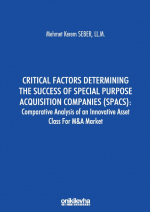 This book is based on the author's dissertation submitted in 2017 as part of his LLM degree in Commercial and Corporate Law at Queen Mary University of London. Special Purpose Acquisition Companies, typically known in the marketplace as 'SPACs', are innovative investment vehicles providing financial resources for M&A transactions from capital markets. The past two years have seen the US SPACs explode in popularity to such a degree that they substantially surpass traditional IPOs in 2021 representing almost 60% of the total new listings.
As part of the need for understanding this trajectory, this book focuses on what the determinants of the US SPACs' success are, which ones are associated with failure and based on these findings, if it is possible to suggest a list of metrics to describe what a model of successful SPAC would look like. The book also provides a general overview of the Turkish regulatory landscape pertaining to SPACs and analyses the reasons why SPACs have remained an untested asset class, which prompted the author's second research question as to whether or not there are any regulatory and contractual improvement areas for the Turkish SPACs, and whether it is possible to offer some key recommendations to practitioners and regulators to increase the attractiveness of the Turkish SPACs.(ARKA KAPAKTAN)
This book is based on the author's dissertation submitted in 2017 as part of his LLM degree in Commercial and Corporate Law at Queen Mary University of London. Special Purpose Acquisition Companies, typically known in the marketplace as 'SPACs', are innovative investment vehicles providing financial resources for M&A transactions from capital markets. The past two years have seen the US SPACs explode in popularity to such a degree that they substantially surpass traditional IPOs in 2021 representing almost 60% of the total new listings.
As part of the need for understanding this trajectory, this book focuses on what the determinants of the US SPACs' success are, which ones are associated with failure and based on these findings, if it is possible to suggest a list of metrics to describe what a model of successful SPAC would look like. The book also provides a general overview of the Turkish regulatory landscape pertaining to SPACs and analyses the reasons why SPACs have remained an untested asset class, which prompted the author's second research question as to whether or not there are any regulatory and contractual improvement areas for the Turkish SPACs, and whether it is possible to offer some key recommendations to practitioners and regulators to increase the attractiveness of the Turkish SPACs.(ARKA KAPAKTAN)
TABLE OF CONTENTS
1. INTRODUCTION
2. EVOLUTION AND THE TYPICAL LIFECYCLE OF THE US SPACS
2.1. Pre-2003 Period
2.2. Post-2003 and Present
2.3. The Typical Lifecycle of the Modern US SPACs
2.3.1. Formation
2.3.2. IPO
2.3.3. Exit: Business Combination or Liquidation
(A) Business Combination
(B) Liquidation
2.4. Flow Chart of a Successful Business Combination
3. CRITICAL SUCCESS FACTORS OF THE US SPACS
3.1. Ownership Structure
3.2. Board Structure
3.3. The Role of SPAC Management
3.4. The Role of Underwriters
3.5. IPO Size
3.6. Escrow
3.7. Target Identification
3.8. Shareholder Activism and Tender Offers
3.9. Market Conditions
3.10. Streamlining Regulation
3.11. Key Success Metrics
4. AN UNTESTED ASSET CLASS: TURKISH SPACS
4.1. Essentials
4.2. The Typical Lifecycle of the Turkish SPACs
4.2.1. Formation
4.2.2. IPO
4.2.3. Exit: Merger or Liquidation
(A) Merger
(B) Liquidation
4.3. Recommendations
5. CONCLUSIONS
BIBLIOGRAPHY
